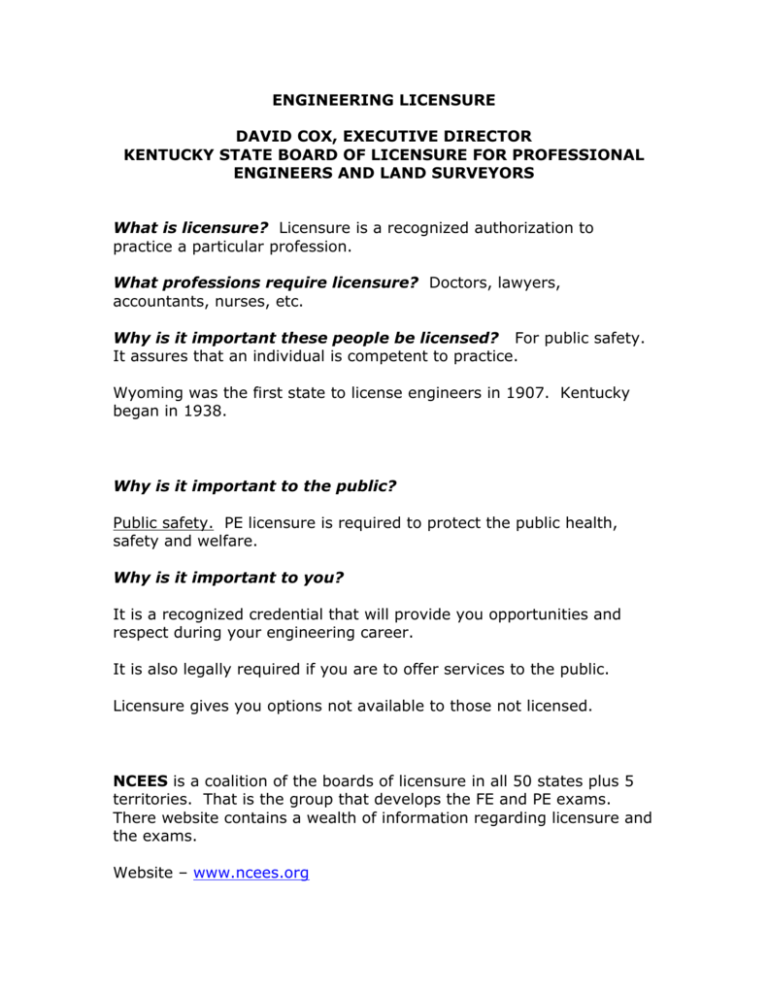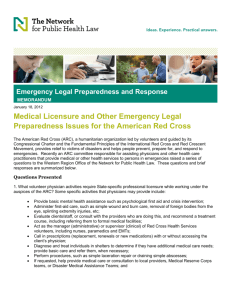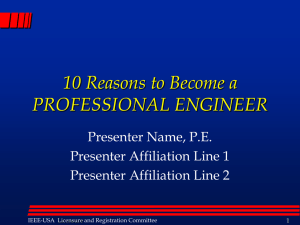PE handout
advertisement

ENGINEERING LICENSURE DAVID COX, EXECUTIVE DIRECTOR KENTUCKY STATE BOARD OF LICENSURE FOR PROFESSIONAL ENGINEERS AND LAND SURVEYORS What is licensure? Licensure is a recognized authorization to practice a particular profession. What professions require licensure? Doctors, lawyers, accountants, nurses, etc. Why is it important these people be licensed? For public safety. It assures that an individual is competent to practice. Wyoming was the first state to license engineers in 1907. Kentucky began in 1938. Why is it important to the public? Public safety. PE licensure is required to protect the public health, safety and welfare. Why is it important to you? It is a recognized credential that will provide you opportunities and respect during your engineering career. It is also legally required if you are to offer services to the public. Licensure gives you options not available to those not licensed. NCEES is a coalition of the boards of licensure in all 50 states plus 5 territories. That is the group that develops the FE and PE exams. There website contains a wealth of information regarding licensure and the exams. Website – www.ncees.org Why bother getting licensed? First, by law, if you offer engineering services to the public you must be licensed. Second, it sets you apart from your competition. Third, professional pride. Fourth, but certainly not last, engineers with their PE license typically hold positions of higher authority and make more money than unlicensed engineers. Four elements on the path to licensure. First is to obtain an EAC ABET accredited engineering degree. You are enrolled in such a program so step 1 is under way. Second is to pass the FE exam. We will cover this in more detail later. Third is to obtain the necessary engineering experience. In most states, including Kentucky, you need 4 years of progressive engineering experience gained after graduation before you can sit for the PE exam. One year of experience credit can be granted for obtaining an engineering master’s degree. The last step is to pass the PE exam. After board approval, it’s official …. You are a licensed Professional Engineer. You now can offer engineering services to the public. You have increased career opportunities. You have professional respect and credibility. You have better financial opportunities. FE Exam Here are some typical questions about the exam. Who should take it? Each year about 41,000 take the exam. 65% of those are students. What is the test like? Effective January 1, 2014, the FE exam will only be offered via computer-based testing (CBT) at Pearson VUE testing centers. The FE exam will be seven freestanding discipline-specific exams: Chemical, Civil, Electrical and Computer, Environmental, Industrial, Mechanical, and Other Disciplines. The exam length will be six hours (110 questions). There will be four testing windows annually. Each of these windows will last two months, with a month between them. March, June, September, and December will be “closed” months during which no exams will be administered. Candidates may take the exam only once per testing window and no more than three times in a 12-month period. The FE exam will continue to be closed-book. The reference handbook will be displayed on the same screen as the exam. Examinees will be allowed to bring NCEES-approved calculators to the test center. A calculator will also be available for their use on the computer if needed. Additional details about computer-based testing including Pearson VUE testing locations are available at http://cbt.ncees.org When should I take it? You can take the exam during your senior year. If you take nothing else from this presentation, take the exam while still in school. The average pass rate while still in school is 75%; it drops to 52% for those out of school two years. How do I prepare? There are a number of companies that produce study materials for the exam including NCEES. Their website lists some of these. It is also a good idea to get a copy of the reference handbook and become familiar with it. PE Exam I know the PE exam is several years down the road so I will just discuss it briefly. Again, it is an 8 hour exam given typically twice per year. However, unlike the FE exam, it is open book. You can bring as many textbooks, references, etc. to the exam as you like. About 26,000 take it each year. The PE exam is offered in 2 different formats depending upon the discipline you take. “No Choice” is an exam where everyone answers the same set of questions. “Breadth and Depth” is more like the FE exam where there are common questions in the morning session that everyone answers. In the afternoon session, you select a module to answer. For example, in the Civil exam (which most of you will take), you can select from Water Resources & Environmental, Geotechnical, Structural, Transportation, or Construction. If you have questions, please contact me at bdavid.cox@ky.gov and I would be glad to help you.











